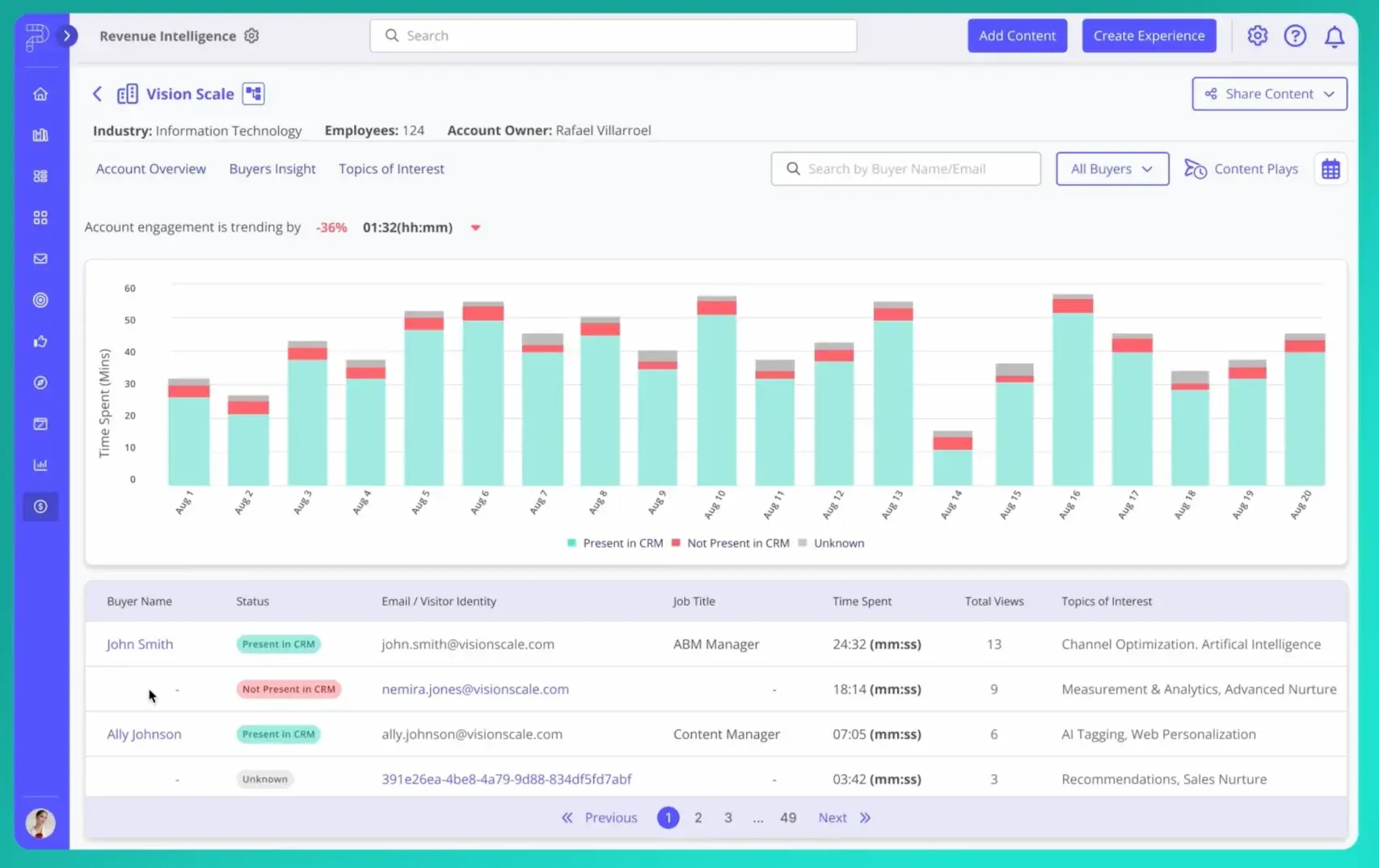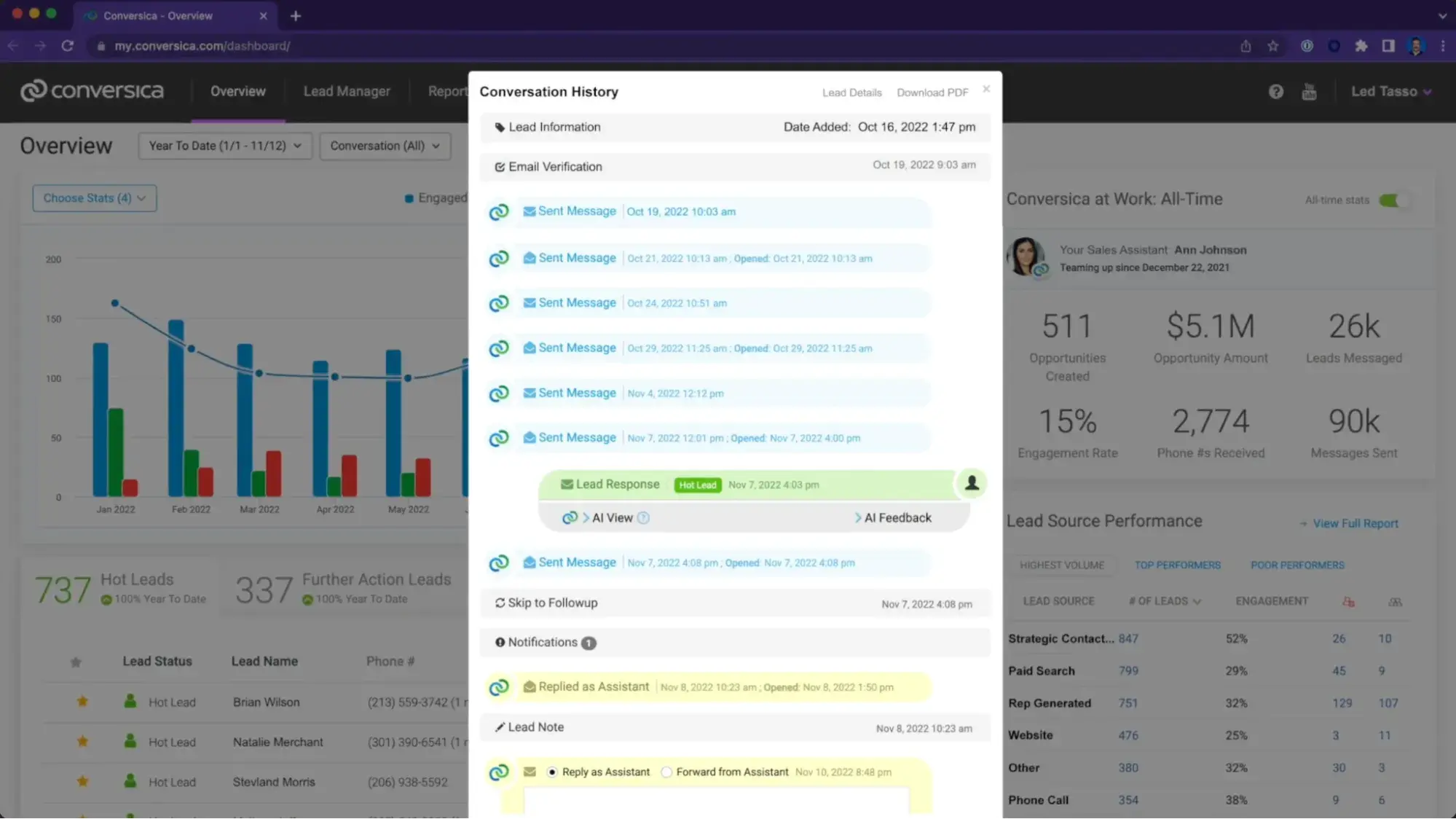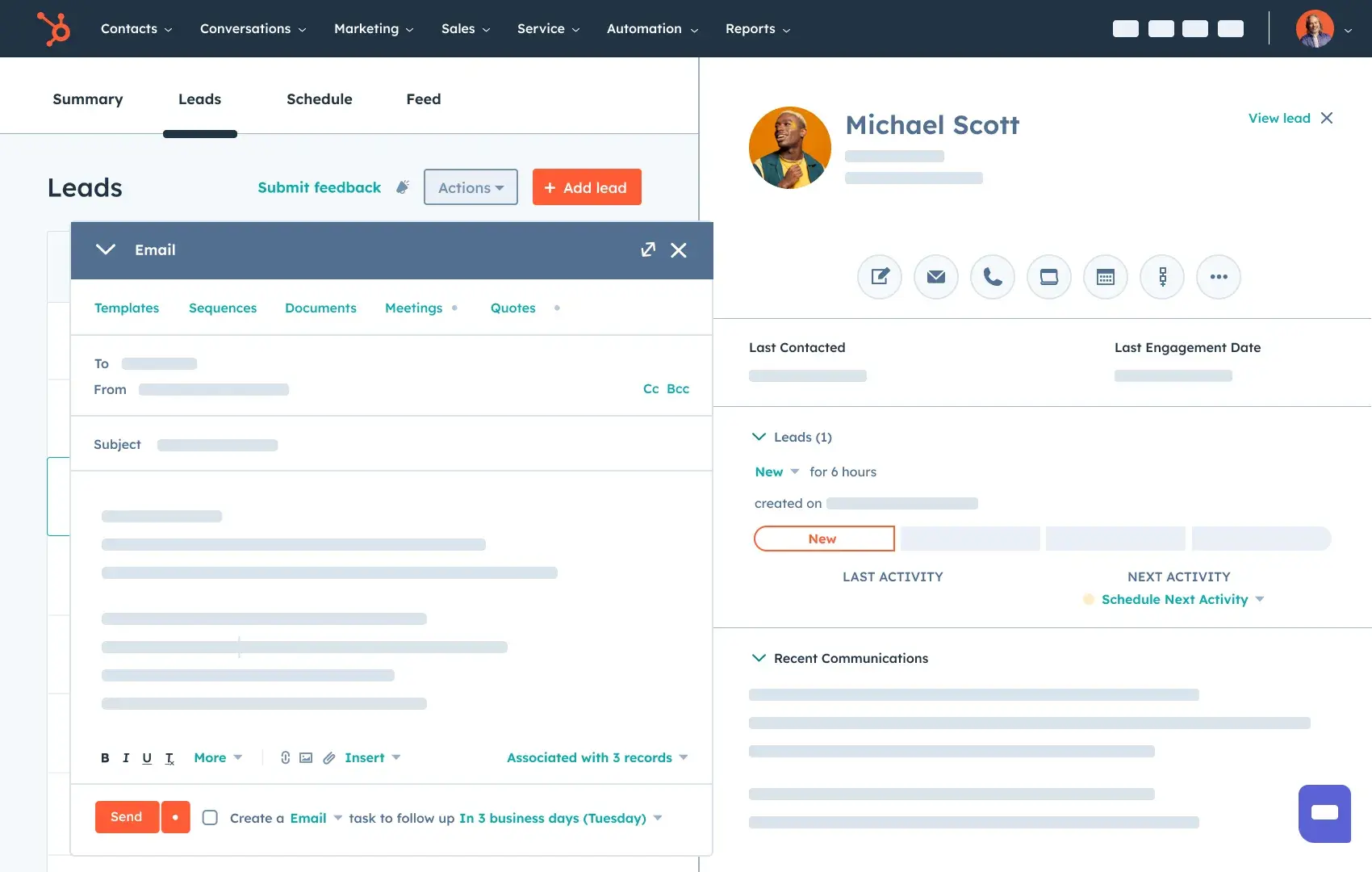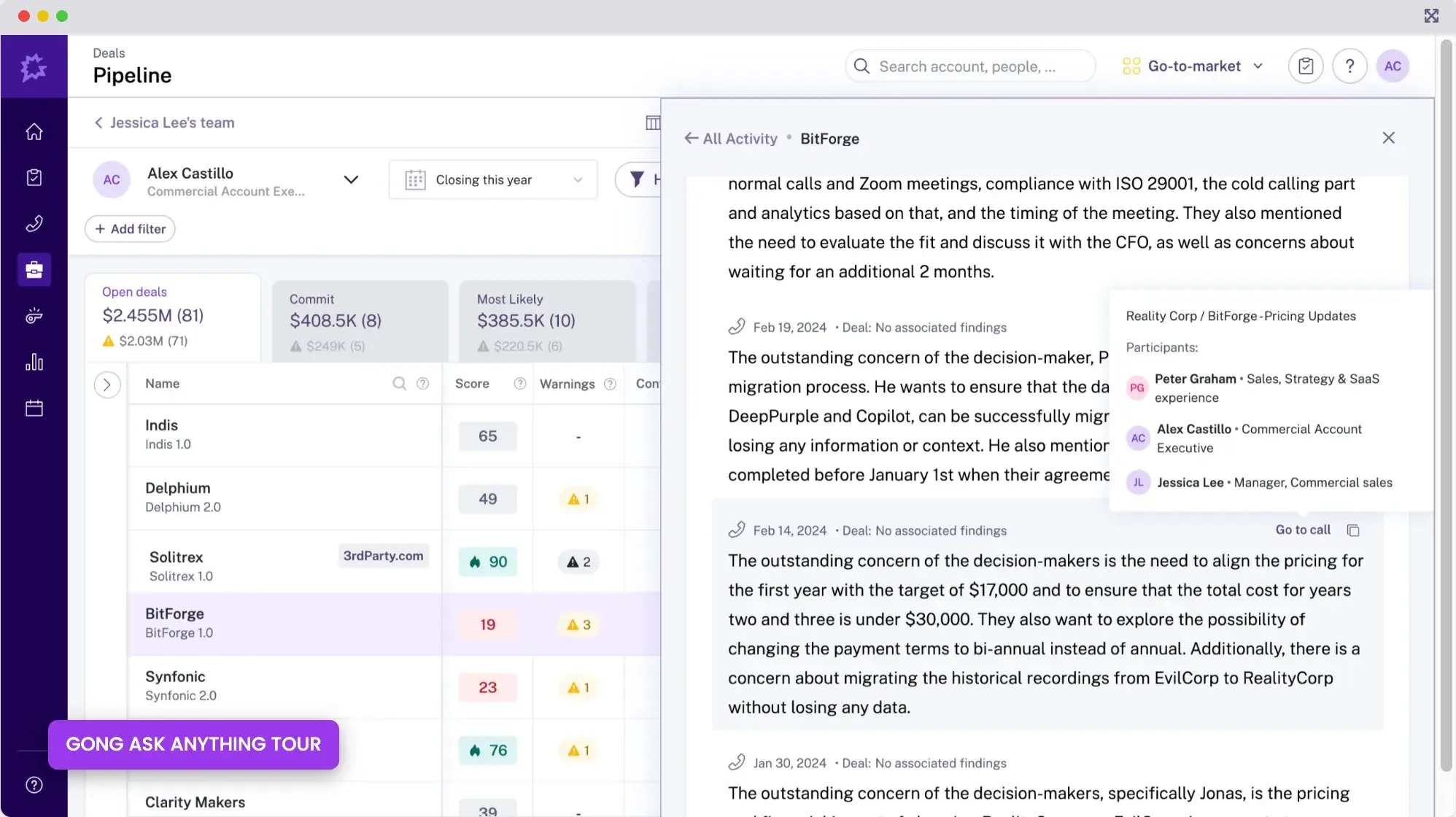Table of Contents
Why Use AI for Sales Follow-Ups
An AI sales follow-up just entails leveraging the strengths of AI — contextual understanding, speed, and scale — to improve the effectiveness and efficiency of your follow-up process.
I’m going to touch on a number of different ways to accomplish this goal, but first let’s break down some of the benefits.
Rapid Personalization
We of course strive to have a deep understanding of all our prospects and their unique needs, but it can be difficult to maintain contextual understanding when you’re juggling dozens of open opportunities.
Fortunately, AI tools like Conversica can fill in the gaps and analyze current and historical data to deliver personalized messages that inspire confidence in your prospects. Or, the next time you’re reaching out to a lead with a long interaction history, paste the entire conversation into ChatGPT and request a quick summary along with some potential next steps to move the deal forward. You’ll probably be surprised at the quality of the response.
Unlimited Availability
Whether a prospect is responding to cold outreach or asking a question that arises after a demo, I try to be as responsive as possible. Still, you can’t (and shouldn’t) always be wiling away the hours in your inbox waiting to be contacted, making this job a perfect one for the latest generation of generative AI technologies.
Take it further: Check out this article on AI sales assistants to see how these tools can log customer notes, generate proposals, outline next steps, and more.
Increased Capacity
A study by Brevet suggests that 80% of closed sales will require at least five follow-ups. When you leverage AI for follow-ups, you’re outsourcing some of the work and increasing the number of opportunities you can juggle at any given time. So go ahead and lean on ChatGPT for that email, or turn to one of the tools mentioned below to offload even more of the labor.
Pro tip: If you prefer to do things the old-fashioned (read: manual) way, check out this article on the art of the follow-up for help keeping those conversations productive — you can be sure each of these touchpoints will require your time, energy, and focus.
How to Use AI for Sales Follow-Ups
1. Generate Email Responses
There are lots of incredible AI tools out there with equally eye-popping price tags, but you can implement a basic AI sales follow-up process without spending a dime.
Next time a prospect reaches out to you via email, head to chatGPT, paste in the conversational history, and have the LLM generate a concise response with the goal of keeping the deal moving forward.
Trying It Out
Augmenting your manual follow-up process with AI is the easiest way to get a quick win and build some momentum, and this approach is how I personally started incorporating the technology into my workflows.
I find it especially useful when a deal has been on the backburner for an extended period. Instead of reading months of messages and meeting summaries before crafting an email, you can leave that to AI and jump right back into the sales flow.
2. Make Content Recommendations
If it’s difficult for your sales team to navigate through your cluttered content library, I’d recommend looking into something like PathFactory. This tool shows your sales team granular data on what content their prospects are consuming, and it even uses this consumption data to recommend what assets they should send prospects next to keep the conversation going.

As you can see in the above screenshot, the tool identifies which leads are consuming the organization’s content, the time they’ve spent browsing it, the number of times they’ve come back to it, and the topics they’re most interested in. This makes it easy for the sales team to reach out and nurture the existing engagement with additional resources and expertise.
3. Automate Communications
Tools like Conversica can have complete conversations with prospects in a variety of channels, nurturing warm leads or warming up cold leads before handing them off to human personnel. The tool integrates with a variety of other technologies (including HubSpot), and can effectively scale your sales team by taking over a large amount of time-intensive manual work. I haven’t explored Conversica but I’m eager to get my hands on it and see what it can do.
In the example below, the AI sales agent has engaged the lead six times before receiving a positive response and labeling the lead as “Hot.” That’s a huge amount of time saved over manual emails that could make a big difference in the capacity of each rep.

4. Improve Targeting
If you’re not willing to hand over conversations to AI just yet, you can instead rely on the technology to help you prioritize which leads you should invest the most time in.
AI lead scoring models such as the one offered in HubSpot’s Sales Hub can look at a variety of inputs and determine how likely a prospect is to convert in the next 90 days. Until it can clone you or add more hours to the day, I believe a data-driven lead scoring strategy is the most effective use of AI.

5. Summarize Meetings
After a day of back-to-backs, your prospect might only have a hazy recollection of your demo or meeting. I’ve had a lot of success using AI tools like Fireflies to generate and send out concise meeting summaries detailing what’s required from all parties to keep things moving forward.
Trying It Out
Once you’ve gotten approval as necessary, sign up for a trial and let Fireflies or Otter.ai join some of your internal Zoom, Google, or Teams meetings to take notes and highlight action items for each member of the team. Once you’ve built some trust in the solution, you can apply the same functions to customer- or prospect-facing roles to ensure everyone is on the same page after each meeting.
6. Improve Messaging
Even when a prospect is an ideal fit, closing the deal requires thoughtful communication. Instead of wondering what you should say next, tools like Gong can analyze how you and your sales team interact with prospects so you can determine what messaging is most effective and spread that knowledge throughout your organization. Gong can also identify your prospects’ objections and concerns, making it easier to ensure they’re being addressed.
In the screenshot below, Gong has flagged and timestamped concerns that are making a deal less likely to close, ensuring a rep has all the information they need to address objections and turn a deal around in time.

Achieving Your AI Ambitions
There’s a spectrum of AI sales follow-up techniques, and you can let the technology make a small tweak to your existing process or hand over the reins in certain instances depending on your budget, needs, and comfort level. If you’re like me, you’ll start out slowly but find yourself placing more trust in AI over time.
Regardless of how deep you’re ready to go down the AI rabbit hole, know that this technology isn’t going to go anywhere. As AI becomes even better at reading intent and communicating with prospects, leveraging AI in the follow up process is going to become an even more essential way to nurture key accounts through the sales funnel and close more deals.
Artificial Intelligence


.png)

![13 Ways AI Can Benefit Your Business [+ New Data and Gen AI Prompts]](https://53.fs1.hubspotusercontent-na1.net/hubfs/53/benefits-of-business-in-ai-1-20241113-8880073.webp)







